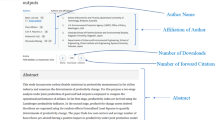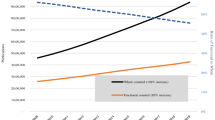Abstract
Firms are increasingly dependent on networks and network visibility for innovation. Bibliometric impact can be regarded as a measure of a firm's visibility in knowledge-producing networks and may explain why companies publish their results. However, this visibility varies across disciplines. This paper examines publications produced by Danish companies in 1996, 1998 and 2000 to show how citation and collaboration patterns relate in different disciplines. The main findings are that for disciplines characterized by international collaboration and many authors per paper, international collaboration results in a greater number of citations. National collaboration does not, however, seem to make any difference to citation impact in industrial research. In disciplines where multinational collaboration and multi-authorship is uncommon, no clear picture of impact patterns can be obtained. By extension, this research may provide knowledge on how citations of papers in scientific journals can be used as a potential window to scientific networks for firms.
Similar content being viewed by others
References
D. J. TEECE, Competition, cooperation, and innovation. Organizational arrangements for regimes of rapid technological progress. Journal of Economic Behavior & Organization, 18 (1) (1992) 1–25.
F. DELLA VALLE, A. GAMBARDELLA, Biological revolution and strategies for innovation in pharmaceutical companies. R & D Management, 23 (4) (1993) 287–302.
W. W. POWELL, K. W. KOPUT, L. SMITH-DOERR, Interorganizational collaboration and the locus of innovation: Networks of learning in biotechnology. Administrative Science Quarterly, 41 (1) (1996) 116–145.
P. A. ROUSSEL, K. N. SAAD, T. J. ERICKSON, Third Generation R&D. Managing the Link to Corporate Strategy. Harvard Business School Press, Boston, Ma., 1991.
S. LIYANAGE, P. F. GREENFIELD, Towards a fourth generation R&D management Model. Research Networks in Knowledge Management. International Journal of Technology Management, (2002) 18.
I. BOUTY, Interpersonal and interaction influences on informal resource exchanges between R&D researchers across organizational boundaries. Academy of Management Journal, 43 (1) (2000) 50–65.
K. KREINER, M. SCHULTZ, Informal collaboration in research-and-development-the formation of networks across organizations. Organization Studies, 14 (2) (1993) 189–209.
E. VON HIPPEL, Cooperation between rivals: Informal know-how trading. Research Policy, 16 (6) (1987) 291–302.
H. A. SHEPARD, Nine dilemmas in industrial research. Administrative Science Quarterly, 1 (3) (1956) 295–309.
J. S. KATZ, B. R. MARTIN, What is research collaboration? Research Policy, 26 (1) (1997) 1–18.
S. KYVIK, I. M. LARSEN, International contact and research performance. Scientometrics, 29 (1) (1994) 161–172.
F. NARIN, E. WHITLOW, Measurement of Scientific Cooperation and Coauthorship in CEC-Related Areas of Science. Report 12900. Luxembourg. Office for the Official Publications of the European Communities.
B. GODIN, Research and the practice of publication in industries. Research Policy, 25 (4) (1996) 587–606.
L. F. FREDERIKSEN, K. HUSTED, Academic publishing activities by Danish companies: a preliminary assessment. VEST Journal for Science and Technology Studies, 15 (2-3) (2002) 9–25.
W. O. HAGSTROM, Scientific Community,Basic Books Inc., New York, 1965.
N. ROSENBERG, Why do firms do basic research with their own money. Research Policy, 19 (2) (1990) 165–174.
D. M. HICKS, P. A. ISARD, B. R. MARTIN, A morphology of Japanese and European corporate research networks. Research Policy, 25 (3) (1996) 359–378.
Y. OKUBO, C. SJOBERG, The changing pattern of industrial scientific research collaboration in Sweden. Research Policy, 29 (1) (2000) 81–98.
G. MELIN, O. PERSSON, Studying research collaboration using co-authorships. Scientometrics, 36 (3) (1996) 363–377.
M. A. HARSANYI, Multiple authors, multiple problems-Bibliometrics and the study of scholarly collaboration: A literature review. Library & Information Science Research, 15 (4) (1993) 325–354.
G. LAUDEL, What do we measure by co-authorships? Research Evaluation, 11 (1) (2002) 3–15.
J. D. FRAME, M. P. CARPENTER, International research collaboration. Social Studies of Science, 9 (4) (1979) 481–497.
T. LUUKKONEN, O. PERSSON, G. SIVERTSEN, Understanding patterns of international scientific collaboration. Science Technology & Human Values, 17 (1) (1992) 101–126.
M. BORDONS, I. GÓMEZ, Collaboration Networks in Science. In: The Web of Knowledge. A Festschrift in Honor of Eugene Garfield, B. CRONIN, H. B. ATKINS (Eds), Medford, N.J., Information Today, 2000, pp. 197–213.
E. GAUTHIER, Bibliometric Analysis of Scientific and Technological Research: A User™s Guide to the Methodology. Science and Technology Redesign Project. Anonymous. Observatoire des Sciences et des Technologies (CIRST). 1998.
D. W. AKSNES, A macro study of self-citation. Scientometrics, 56 (2) (2003) 235–246.
H. HERBERTZ, Does it pay to cooperate? A bibliometric case study in molecular biology, Scientometrics, 33 (1) (1995) 117–122.
A. F. J. VAN RAAN, The influence of international collaboration on the impact of research results-Some simple mathematical considerations concerning the role of self-citations. Scientometrics, 42 (3) (1998) 423–428.
A. VERBEEK, K. DEBACKERE, M. LUWEL, E. ZIMMERMANN, Measuring progress and evolution in science and technology-I: The multiple uses of bibliometric indicators. International Journal of Management Reviews, 4 (2) (2002) 179–211.
T. J. PHELAN, A compendium of issues for citation analysis. Scientometrics, 45 (1) (1999) 117–136.
S. FULLER, Science, Open University Press, Buckingham, 1997.
Y. KUBO, Bibliometric Indicators and Analysis of Research Systems: Methods and Examples. STI Working papers 1997/1. Organisation for Economic Co-operation and Development.
Author information
Authors and Affiliations
Rights and permissions
About this article
Cite this article
Frode Frederiksen, L. Disciplinary determinants of bibliometric impact in Danish industrial research: Collaboration and visibility. Scientometrics 61, 253–270 (2004). https://doi.org/10.1023/B:SCIE.0000041651.26664.14
Issue Date:
DOI: https://doi.org/10.1023/B:SCIE.0000041651.26664.14




